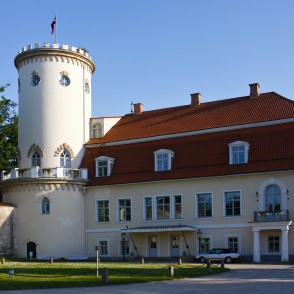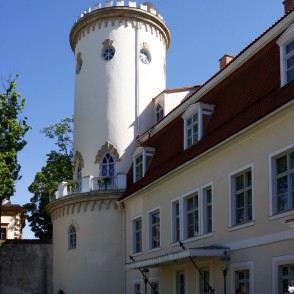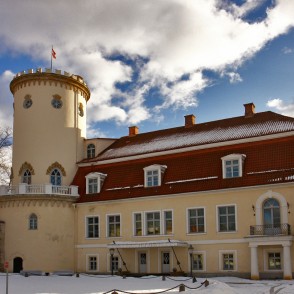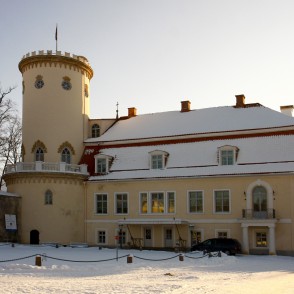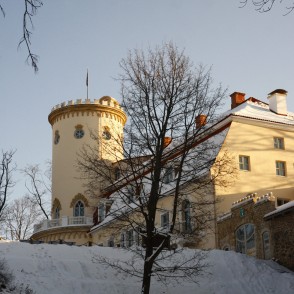The Cesis manor house or the Cesis New Castle was built in the 18th century as part of a medieval castle fortification system – in place of a protective building for the tower and the gates. Today, it is operated by the Cesis History and Art Museum.
The Cesis History and Art Museum
The museum takes pride in its collection of historical materials on Latvia's red-white-red flag.
While visiting the Cesis History and Art Museum:
- take a look at the history and interiors exhibition "Cesis - a symbol of Latvian history";
- see Cesis from the castle tower and take a look at the city's oldest inhabitant – the Vends mound, the ruins of the Livonian Order's medieval castle;
- participate in thematic and interactive programs.
After seeing Cesis' history and art museum, go on a tour of the nearby Cesis medieval castle.
The Cesis Castle also has a Cesis Tourist Information Centre.
Interior
Quite interesting are the Castle's restored and reconstructed interiors – count Sievers' study, coffee room and the castle library.
Cēsis district, Pils laukums 9, Cēsis, LV-4101
+371 64121815
+371 28318318
pils@cesis.lv
www.cesupils.lv
Cēsis New Castle, together with the territory of the Castle manor historic centre and the Livonian Order medieval castle ruins makes one of the most important and romantic historical attractions of Vidzeme region and Eastern Baltic. New Castle is one of the few 18th-century Castle manor houses in Latvia, built into the medieval fortification system – instead of the tower and the gate protection building. Its history covers almost five centuries. Since 1949, the Cēsis History and Art Museum has been established in the building of the New Castle.
turisms.cesis.lv
History of the manor house
Cēsis castle manor house, together with the historical centre of the castle-manor and the medieval castle ruins of Livonian Order form one of the most important and romantic attractions in Vidzeme region and Eastern Baltic. The manor house is one of the few which were used as a residence in Latvia in 18th-century, and which has been built within a medieval fortification system. Its history is nearly five centuries old.
The exact year of construction of the manor house is not known. It was built around the year 1761 when the manor belonged to the Von Wolff family. In 1777 the property was bought for 96,000 thalers from Baron Karl von Adam Wolff by Major and later Count Karl Eberhard von Sievers (Sievers, 1745 to 1821). Count Sievers family lived in the manor for five generations until the agrarian reform of Latvian Republic in 1920. During this time, a manor management was developed and the Castle`s historical complex was created which is still visible nowadays.
All major reconstruction in the manor house took place between 1820–1830 and 1840–1850, when the Castle was owned by Count Carl Gustaf von Sievers (Sievers, 1772 to 1856). At the time the massive medieval tower was elevated by two smaller floors, smaller in terms of diameter and the main Baroque style volume was supplemented with balconies and columns in the main facades.
Manor house’s Lademaher tower is decorated with sharp-bow arcades and the openings are considered to be one of the first examples of neo-Gothic in Latvian manor architecture. By contrast, the interior is dominated by the early Classicism and Biedermeier style characteristics of interior decoration of the first half of the 19th century.
Counts Sievers family lived in the manor house until the World War I. In 1919, after the battles of Cēsis, during Latvian Freedom fights, the building was occupied by Northern Latvia Civil administration. During these events, many of manor’s interior accessories were destroyed, including a large library of Count Sievers. In 1922 the building was taken over by the Latvian army and until 1940 it served as the headquarters of the Daugavpils 8th Infantry Regiment of the Latvian army and officers’ club. After World War II the building was turned into an apartment building, and Cēsis History and Art Museum was established in the New Castle in 1949.
After the restoration of the Cēsis manor house between 2007–2012 the former residence of Count Sievers family regained its historical appearance. Within the building an exhibition displays the history of Cēsis which is a part and symbol of Latvian culture
cesupils.lv

